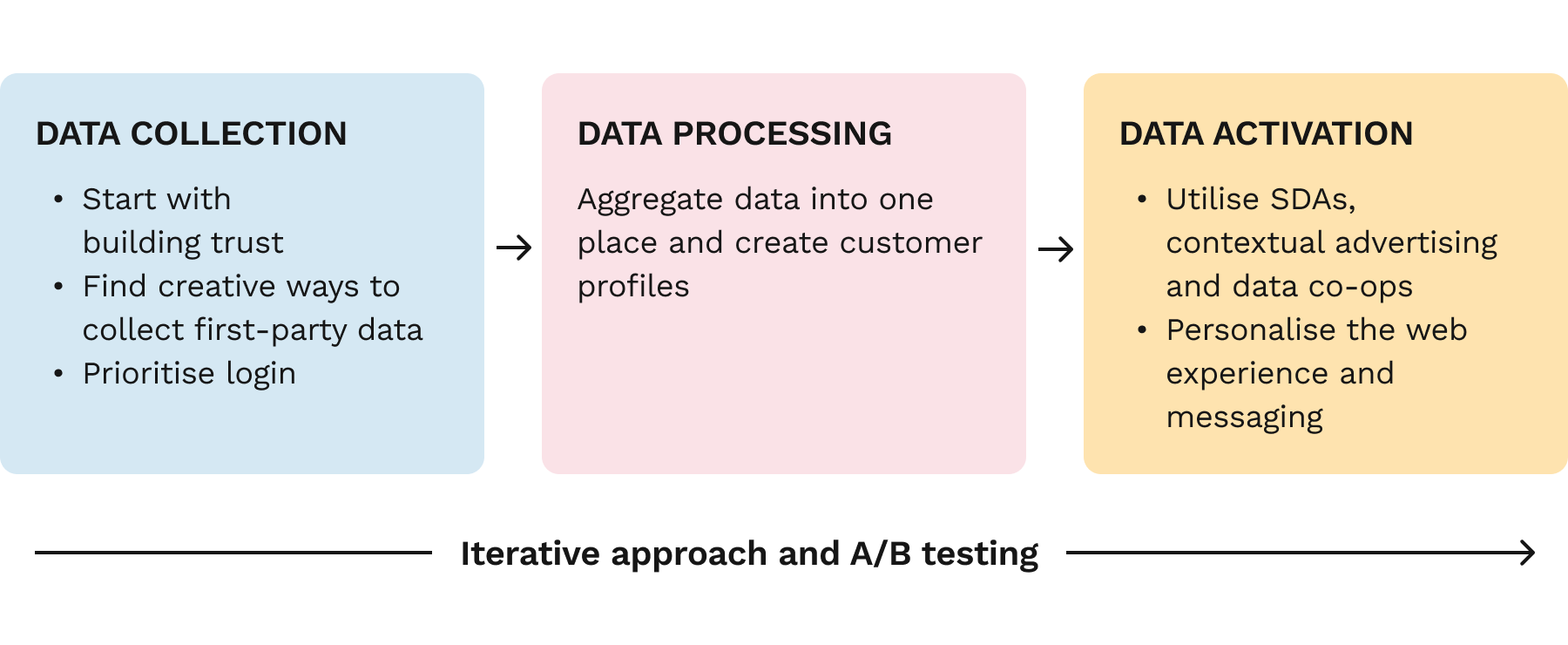Checklist for cookieless marketing
Get a head start on the cookieless future with this downloadable checklist!
Download the checklistThe world of digital sales is about to change with the end of third-party cookies. The change forces marketers to rethink how they can reach the right audience digitally. While going cookieless might be a significant challenge, there remain vast opportunities for those who can collect, process and leverage first-party data creatively and efficiently. In our new "Going cookieless" series, we’ll explore each in depth.
To lay the foundation for the change ahead, it’s crucial to understand the four types of data available to marketers:
- Zero-party data: Collected when users intentionally share information with a website or entity via, for example, a survey or a quiz.
- First-party data: Collected and owned by the company itself. For example, website data, mobile app data, and CRM data.
- Second-party data: Collected as a result of corporate cooperation.
- Third-party data: Delivered by data providers and available on the market for purchase. Can be based on third-party cookies and is owned by another domain.
When we talk about the cookieless future, we refer to the fact that the use of third-party cookies will be restricted. Third-party cookies are used to track user behaviour across multiple websites. While they help serve targeted ads, they are also seen as intrusive and raise serious privacy concerns.
As a result, some of the main web browsers, such as Safari and Firefox, have decided to block third-party cookies. Following that path, Google has announced that by the second half of 2024, the Chrome browser – with a market share of 70% – will also block third-party cookies.
This change will inevitably change the digital sales and marketing landscape. It will be increasingly difficult, if not downright impossible, for marketers to utilise tactics such as retargeting, reporting conversions from platforms, building visitor audiences based on behaviour and activating third-party audiences.
While we often talk about the cookieless future, this development is not only an issue that awaits us somewhere down the road. Already now, you don’t know what every fourth visitor does on your website! More than 25% of users decline, ignore or block your cookie consent banner. Moreover, the usage of ad blockers is increasing year over year.
What can marketers do about the change?
In the future of digital sales and marketing, it is increasingly important to be able to collect, process and activate the data available to us well. This means an increased focus on zero-party, first-party and second-party data.
The success formula of the cookieless future looks a little like this:

Starting with data collection, marketers won’t be able rely on having third-party data available for purchase. Instead, the focus should be on building trust, collecting first-party data in creative and compliant ways as well as prioritising customer-centric login on your website. Once data is collected, it ought to be processed, analysed and aggregated in one place to create a holistic view of your customer. Finally, the collected data must be leveraged and activated creatively to offer personalised and relevant experiences to your customer.
To help you navigate the change, in our series of blog posts, we do a deep-dive into each of the three parts and deliver actionable insights on each.
Read the other parts of the series:
The digital sales and marketing landscape is set to face a major challenge with the disappearance of third-party cookies. At Columbia Road, we see this as an opportunity for those who are ready to adapt and embrace change.
As a premium partner in digital commerce, we specialise in building seamless digital solutions and running concrete growth activities that help businesses sell better. Our cross-functional teams work hands-on and take ownership of your business goals. Data is in our DNA, and we always deliver results – even in the cookieless future of digital sales.
The Data Handbook
How to use data to improve your customer journey and get better business outcomes in digital sales. Interviews, use cases, and deep-dives.
Get the book




